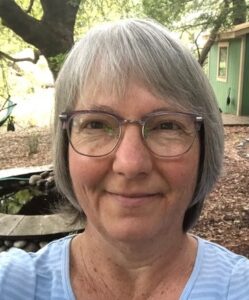Befriending Fear
Nancy Voogd, a member of our Restoring Resourcefulness Faculty, has written about her journey with fear. She offers readers her discoveries and invites us to make our own.

Befriending Fear
I have been on a journey with fear for a while now. Before COVID, I had a felt sense of what fear felt like in my body. I was aware when my jaw felt tight, or when my stomach was doing flips or when the weight of faint landed on my head. And about a month ago, I became aware that I wasn’t feeling or noticing those things. In fact, when I looked further, I realized that I wasn’t feeling anything other than the swirl of vertigo. So I got curious about what might lead me back to my body wisdom.
And then my friend, Maurie, made a comment about noticing her fear by noticing the quality of her thoughts. With my curiosity piqued, I started looking to see if there were thought forms that might point me to my fear. I found distinct fear thought forms for each of the four expressions of fear.
I share my discoveries here, in the hopes that they may spark your own.
Here’s what I’ve discovered:
If I’m thinking critical thoughts, towards myself or others, it’s highly likely that I’m in the ‘fight’ expression of fear, so I ask myself, “Am I scared?”
If I’m time-traveling (meaning I’ve gone to a memory of the past or an idea of the future and am busy trying to figure something out), then it’s likely that I’m experiencing the ‘flee or flight’ expression of fear. Again, the question I ask myself is “Am I scared?”
If I’m frozen in time, with a loop of the last thing that scared me playing over and over in my head, that’s a Freeze thought form. Am I scared? (So far the answer has always been a resounding Yes.)
And this last fear expression, Faint, this one is almost all thought forms, very few actual body sensations associated with this fear. Feeling overwhelmed, or dazed, sleepy for no logical reason, confused without curiosity, those are all thought forms that pointed me to Faint. When I notice that sort of fog around my thinking, I ask myself: Am I scared?
Invariably, each time I ask myself if I’m scared, a big breath rolls through my body as if it were responding, “Yes! Thank you for noticing!”
What I’ve been loving about this practice is that the simple act of asking the question and allowing myself to respond brings about enough space that I can then access the thought to do Fear Melters®, and then I’m on my way back to presence.
But don’t take my word for it. If it’s interesting to you, see what you notice. Ask yourself if you’re scared if you notice any of those thought forms buzzing about your head, or coming out of your mouth. And then notice what you notice.
Nancy Voogd


